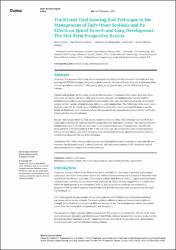Traditional Dual Growing Rod Technique in the Management of Early Onset Scoliosis and Its Effects on Spinal Growth and Lung Development: The Mid-Term Prospective Results

Göster/
Tarih
2021Yazar
Cengiz, BertanÖzdemir, Hacı Mustafa
Sakaoğulları, Abdurrahman
Işık, Metin
Aydoğan , Nevres Hürriyet
Üst veri
Tüm öğe kaydını gösterKünye
Cengiz B, Ozdemir H, Sakaogullari A, et al. (April 11, 2021) Traditional Dual Growing Rod Technique in the Management of Early Onset Scoliosis and Its Effects on Spinal Growth and Lung Development: The Mid-Term Prospective Results. Cureus 13(4): e14422. DOI 10.7759/cureus.14422Özet
Objective: The purpose of this study was to investigate the safety and effectiveness of the traditional dual growing rod (TDGR) technique, using only pedicle screws for fixation with more frequent lengthening while evaluating scoliosis correction in the growing spine, spinal growth rates, and the differences in lung volumes.
Patients and methods: In this single-centre prospective study, 27 patients with a follow-up of over three years were included in the study. Only pedicle screws were used as foundations for fixation. Routine lengthening procedures were performed every six months. Data were recorded including the age of initial surgery, gender, number of lengthenings, follow-up, and complications. The Cobb angle of the major curve, kyphosis angle, T1- S1 length, space available for lung (SAL) ratio, coronal and sagittal balance, and the height of all patients were measured and recorded preoperatively, immediately postoperatively, and finally before and after every lengthening.
Results: The average follow-up time was 46.3 months (36-64 months). The correction rate was 69.5% for Cobb angle and 43.2% for kyphosis between preoperative and final follow-up period. The time between two lengthenings was 6.9 months, and the mean T1-S1 length increase was 1.78 cm per year. The SAL ratio increased from 0.885 preinitially to 0.985 at the last follow-up. The complication rate was determined as 9.6% in 187 procedures. Acceptable improvements were determined in the specified parameters with low complication rates with the use of this technique.
Conclusion: The TDGR technique with proximal and distal pedicle screws as anchors is a safe and effective treatment for deformity control in selected patients with early onset scoliosis (EOS). Repetitive surgical interventions are the negative side of this technique.
Kaynak
Cureus Journal of Medical ScienceCilt
13Sayı
4Bağlantı
https://assets.cureus.com/uploads/original_article/pdf/56392/20210412-543-8qc9q3.pdfhttps://hdl.handle.net/20.500.12809/9180

















